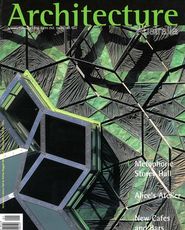|

The Swanston Street Facade.

The auditorium, with backlit acrylic and MDF ceiling tiles inspired by Roger Penrose.

On the mezzanine at level 5, looking along the upholstered balustrade of the balcony outside the auditorium.

Entry foyer with curved staircase overhead.

Level 5, with the auditorium’s main doors
at left.

The rear of the auditorium, showing original columns supporting a historic balcony.
Windows face Swanston Street.

RMIT’s Swanston Streetscape, showing how ARM’s Storey Hall relates to the Corrigan/Demaine Building 8 and existing Victorian edifices.

Level 4 plan (gallery and mezzanine).

Level 5 plan (annexe foyer, hall, auditorium).

Landing of the curved stairs, giving access to offices and the gallery.

Gallery One, restored within the original
building

North/south section looking east.

East/west section through annexe.
|
Storey Hall at RMIT is the product of an energetic creative spirit held by the architect and a courageous client.
It should be considered in the context of other RMIT explorations in architecture (including Building 8 by Edmond and Corrigan and a new Arts Building by Allan Powell) which have occurred under the enlightened patronage of Vice-Chancellor David Beanland, guided by the Dean of the Faculty of Environmental Design and Construction, Professor Leon van Schaik.
Storey Hall comprises a large auditorium (the original Storey Hall, which has been recycled using the original Victorian balustrade and internal form but into which has been inserted an upper level of seats and projection facilities). It has been totally immersed in an applied tile pattern of spectacular white, green, pink, purple and redpanels, with inset green neon lights and great panels of white translucent and reflected light fittings. There are small spotlights and lights inlaid in the parquetry flooring. The building also contains offices, a smaller lecture theatre, a range of galleries and associated lobbies and bars.
Some critics have called it Melbourne’s largest hair salon.
But it is an architecture of density and wit, critical and of its moment: one that requires translating, where interpretation will not be wasted and where knowledge—above all—is needed to understand fully what an architecture of genuine complexity contains.
Beware the facile sentiment that the building may appear to be a sophisticated but paradoxical adventure. The creative approach underpinning Storey Hall resembles Oxford don Roger Penrose’s conjectures of creative growth, which, he argues, occurs in complex three-dimensional patterns rather than by algorithm (simple sequences).
The bronze Penrose tiles on the face of the building are repeated within the main hall as a mixture of plastic, plaster, colour and light grids. (There are two Penroses—the elder, LR, was involved with experiments with multi-faceted staircases and optical illusion since the 1930s, when he influenced the artists Escher and Ernst. His son, Roger, was involved also with these beguiling patterns and games, although his work related to relativity and quantum theory. His tile pattern used at Storey Hall comprises two tiles, a dart and a kite, which are assembled in infinite variations. It contains a metaphor for a Penrose vision for the universe—a seemingly deregulated system which has large and small elements in an infinite realm.)
“an evolving quantum linear superimposition of many different alternative arrangements”—Roger Penrose, 1990, The Emperor’s New Mind.
Of course, such an application in architecture is in part a diversion; there’s a kind of scruffy-minded, nerdy context being played by architects Ashton Raggatt McDougall (ARM), which centres on a richly complicated narrative as if a script (or set of codes) had been prepared prior to the building being designed.
Among those divertive commands we uncover chaos theory, Walter Burley-Griffin, urbanism, the sexual revolution, feminism, Einstein’s grotto, Plato’s cave, X and Y chromosomes, the Vault sculpture, paradoxes, contextualism, techno music, Australian-Irish Melbourne, politics and architectural quotations.
But I suspect that underlying the architectural bravado—with all that intense complexity of forms, colours and materials—the building is ultimately a celebration of the human condition, which reflects also its place and time.
A particular city context becomes transparent at the end of the foyer with a replica of the Yellow Peril built as a wall backdropping the bar (based on Ron Robertson-Swann’s much-abused Vault sculpture), and overhead is a truculent bridge leading to an outside balcony overlooking Melbourne.
To make more of its urban and historical appropriateness, the auditorium contains a suspended Penrose-patterned ceiling which is richer and as compelling as Griffin’s 1924 Capitol Theatre ceiling and achieved within the limits of historic buildings legislation which applies to the old hall, so that an existing cast-iron balcony and delicate Victorian staircase must remain. The restored staircase now heads directly into a solid wall.
A small lecture theatre foyer is a grotto, an Einstein cave of grey concrete and coned columns, expressing an almost maudlin humour with a scale which compresses the space, squeezing people together, enforcing a discipline to stand, mechanically erect I expect—or perhaps the architects plan to morph the public into an homogenous, promiscuous new tribe.
“I was seized with a great curiosity, not so much to see them, or to be seen by them either—since first, we hadn’t any sight and secondly, the sexes weren’t yet differentiated“—Italo Calvino, 1969, Cosmicomics.
Enormous X and Y chromosome graphics on the auditorium walls represent literal signs of contemporary social issues of gender, while toilets coloured pink for the boys and purple for females beg the question … you are what?
There are contradictions throughout. Like the facade to Swanston Street, which is a site-poured concrete wall, twisted according to the new geometry of complexity, painted on the lower level a deep purple and above that a computer-enhanced livid green. Where the colours meet they are smudged, according to ARM, “like smeared lipstick”: the fuzzy world of explicit sexuality, feminism and Melbourne Irish politics becomes unclear (the colour of feminism is purple, the Irish, well … ).
Over those emblems are a number of Penrose-shaped cast bronze tile panels, fixed away from the wall and interspersed with green tube lighting. The foyer leads down into a lecture theatre and across the lobby to a large theatre which is located in the original Storey Hall. Slicing through the lobby is a spiralling Piranesi concrete stair leading up to a number of galleries and a large foyer attached to the auditorium.
Storey Hall appears to deal with what Peter Eisenman signals as “the post Platonic” period of architecture, which he defined as one suitable for the next millennium—a period of fuzzy logic and inextricable order—where rules of Platonic harmony and prescription no longer apply.
Charles Jencks announces it as “cosmogenic” architecture, which he says is the built representation of developments in scientific theories of chaos and cosmic organisations. In other words, there is a cultural propensity for things to do with chaos theory and a view of a world ordered more by mayhem than generic and social regulation.
“In a flash, all over the drum and smeared on the disc, in a critical condition now squeezed through the bubble jet, till finally of course, just maggots all over, everywhere cursed as messy, whimsical and degenerate, but with everything splattered or in perfect tesselations there is surely somewhere a voice murmuring resurrection”—Howard Raggatt, 1993, Fin de Siecle? And the 21st Century.
Raggatt’s description of architecture could be Storey Hall, which encompasses deep meaning and intentionally more than merely a visible and three-dimensional link between current scientific theories of the meaning of existence—and constructed architecture.
It is a building of endeavour and industry, celebrating individual qualities of making things, materials , textures, casting metals, colouring walls, and the power of imagination which adapts new communication and transmission technology … up to a point … but like Penrose, Storey Hall seems in the end to argue the glory of the human mind over that of artificial logic.
With that reasoning alone, ARM achieve at Storey Hall a quantum leap (I mean combining pure and applied considerations) which encourages others to an open search rather than one dictated by dogma.
Like a piece of fine music, this is architecture to be used and experienced, not simply looked at. Visitors to this building can sense the composition, like a musician resting between chords, before heading back into the chaos of swirling concrete stairs and green sheets of light.
Images: Tim Griffith
|




























